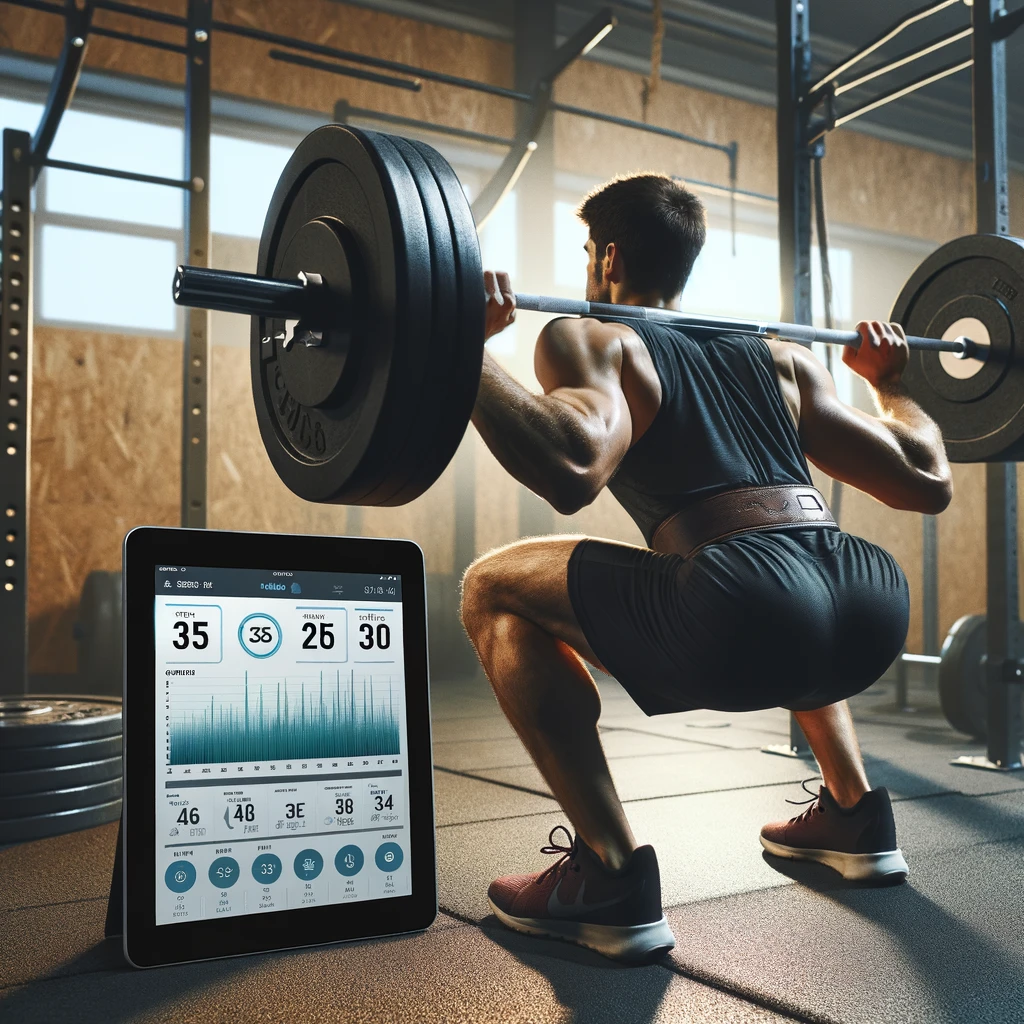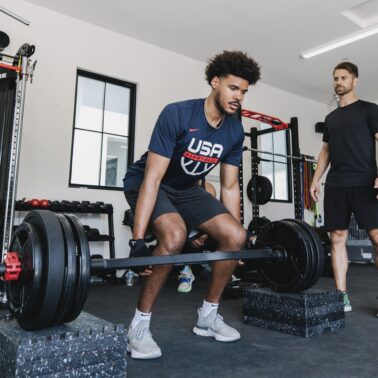“Sprint speed, squat testing , grip strength, or gait speed are all similar… They’re all expressions of task specific neuromuscular output.”
Adam Loiacono
What You Will Learn
- An extensive view into what strength really is.
- Why strength is often the most overlooked training principle.
- Advice on how to develop strength.
What is Strength?
Strength, in its simplest form, is the ability to exert force. It’s a fundamental physical attribute, integral not only to sports and fitness but also to everyday activities and overall health. Understanding strength and its importance is crucial for anyone looking to improve their physical well-being.
The Physics of Strength
At its core, strength is an expression of the physics equation Force = Mass * Acceleration. This equation illustrates that strength is not just about how much weight you can lift (mass) but also how quickly and efficiently you can move (acceleration). This combination of speed and power is essential in various physical activities, from lifting groceries to sprinting.
Various expressions of Strength
Maximal lower body strength, maximal velocity in sprinting, gait speed in the elderly, and grip strength might seem like disparate physical attributes, but they are all interconnected as expressions of neuromuscular output. This concept is rooted in the understanding that neuromuscular output refers to the ability of the nervous system to generate a muscular response. This response is critical in various physical activities, from high-intensity actions like sprinting to daily life movements like walking.
Starting with maximal lower body strength, it is the foundation of many physical activities. It involves the ability of muscles in the lower body, such as the quadriceps, hamstrings, and glutes, to generate maximal force. This strength is crucial for explosive actions like jumping or sprinting, where rapid force production is key. Maximal velocity in sprinting, on the other hand, is a direct outcome of this force production combined with the efficiency of the neuromuscular system to coordinate and execute rapid, powerful movements.
Gait speed in the elderly is a more subtle but equally important manifestation of neuromuscular output. As we age, neuromuscular efficiency can decline, leading to slower and less stable walking patterns. Gait speed, therefore, becomes an important indicator of neuromuscular health in older adults. It reflects not just muscle strength, but also coordination, balance, and the overall integrity of the neuromuscular system.
Lastly, grip strength, often overlooked, is a significant marker of overall neuromuscular function. It’s not just about the hand and forearm muscles, but also about the neural control and coordination required to perform gripping actions. Studies have shown that grip strength is a reliable predictor of overall muscle health and has been linked to broader health outcomes.
Absolute vs Relative Strength
Absolute strength refers to the total amount of force one can exert, regardless of body weight or size. It is often measured by the maximum weight one can lift in exercises like deadlifts, squats, or bench presses. This metric is most relevant in contexts where the total amount of force is important, such as weightlifting competitions.
Relative strength, on the other hand, considers an individual’s strength in relation to their body weight. This is typically calculated by dividing the maximum force or weight lifted by the individual’s body weight. Relative strength is particularly significant in sports and activities where one must move or control their own body, like gymnastics or rock climbing. It highlights how effectively one can manage or maneuver their body using their strength.
Relative strength is my preferred means of assessing strength because then we can easily compare athlete to athlete.
Why is Strength Important?
lessons from Longevity
Age-related strength and muscle mass loss, known as sarcopenia, becomes a significant concern after the age of 30. On average, adults lose 3-8% of their muscle mass per decade after this age. This loss accelerates after the age of 60. The decline in muscle mass is coupled with a reduction in muscle strength, estimated to decrease at a rate of approximately 1-2% per year. By the age of 70, the average individual may have lost about 25% of their peak muscle mass and strength. Additionally, by the age of 80, this loss can reach up to 40%. These changes are attributed to various factors, including hormonal changes, reduced physical activity, and alterations in muscle composition and function.
Strength training plays a pivotal role in mitigating sarcopenia and age-related losses in muscle strength. Engaging in regular resistance exercise can significantly slow down the loss of muscle mass and strength that typically occurs with aging. Studies show that even moderate strength training, when performed consistently, can increase muscle mass by 1-3% and improve muscle strength by 10-30% in older adults.
Injury Risk Mitigation
The research article “Can the workload–injury relationship be moderated by improved strength, speed and repeated-sprint qualities?” by Malone et al. presents compelling evidence on the importance of strength as a modifiable risk factor for injury prevention in athletes.
According to Malone et al., athletes who possess higher levels of strength experience fewer injuries. Specifically, the research indicates that for every 10% increase in relative strength, athletes see an approximate 4% decrease in injury risk. This statistic underscores the protective effect that strength training has against the strain placed on the body during high-intensity activities. The study also highlights that improved strength, when combined with enhanced speed and repeated-sprint qualities, contributes to a more resilient athlete, capable of withstanding the rigorous demands of their sport.
Strength exists across all athletic performances
Strength is the cornerstone of athletic performance, underpinning every movement from the simplest jog to the most complex gymnastic routine. At its core, strength is about the ability to exert force, and this is where physics comes into play. Newton’s Second Law of Motion, F = ma (Force equals mass times acceleration), is pivotal in understanding this. In athletic contexts, ‘mass’ can be the athlete’s body weight or the weight of equipment they’re using, and ‘acceleration’ refers to the speed at which they can move this mass.
This principle applies universally across both lower and upper body movements. For lower body activities like squatting or jumping, greater strength allows an athlete to propel a larger mass (their body plus any additional weights) upwards against gravity at a faster rate, resulting in higher jumps or more powerful sprints. Similarly, in upper body movements like a bench press or a pull-up, strength enables the athlete to move their own body weight, or additional weight, against gravity.
Understanding and improving strength is about more than just muscle size; it’s about enhancing the efficiency and effectiveness of these force-producing movements. Every athletic action, whether it’s a swimmer’s stroke or a boxer’s punch, is ultimately a manifestation of this fundamental principle of force. Thus, a well-rounded strength training program that addresses both the upper and lower body is essential for athletes looking to improve their performance across the board.
How much Strength do you need?
Determining “how strong is strong enough” in the context of athletic performance hinges on various factors, including the specific sport, individual goals, and the athlete’s body composition and health. For instance, strength requirements differ vastly between a marathon runner and a weightlifter.
Moreover, the concept of “diminishing returns” is crucial. Beyond a certain point, additional strength gains might not significantly enhance performance and could even be detrimental by increasing injury risk or compromising other performance aspects like endurance or flexibility.
In endurance sports, excessive muscle mass can hinder performance. Too much muscle mass may negatively effect the ability to perform extensive workouts. One reason is because as muscle mass increases, the demand for fuel increases. In endurance runners, efficiency is key. It is amazing how each sport will produce a particular body type based on the demands placed on the body by the sport itself.
Ultimately, “strong enough” is a balance. Athletes should aim for a level of strength that maximizes performance in their specific sport, considering individual differences and avoiding the pitfalls of overtraining or focusing excessively on strength to the detriment of other crucial performance factors. Regular assessment and a well-rounded training program tailored to the specific demands of the sport are key to achieving this balance.
How do you improve strength?
Improving physical strength involves a multifaceted approach, incorporating various training methodologies. Two effective strategies are Velocity-Based Training (VBT) and Isokinetic Training.
Velocity-Based Training is a method where the speed of the lift is the primary focus rather than the weight lifted. It’s particularly useful because it helps in optimizing the load and intensity for maximum power output. By monitoring the velocity, one can ensure they are training at the right intensity to stimulate strength adaptations without overtraining.

Isokinetic Training, on the other hand, involves exercises at a constant speed, regardless of the force exerted. This method is effective for controlled muscle strengthening, often used in rehabilitation settings. It ensures that muscles are engaged throughout the entire range of motion, leading to balanced strength development.
Additionally, incorporating isolated exercises can significantly enhance the strength of compound movements. Isolated exercises target specific muscle groups, leading to increased muscle strength and endurance. This, in turn, contributes to better performance in compound movements, which require coordinated action from multiple muscle groups. By strengthening individual muscles through isolation exercises, one can improve their overall capacity to perform complex movements, thus enhancing overall physical strength.
Overall, a combination of VBT, Isokinetic Training, and targeted isolated exercises can lead to substantial improvements in physical strength. Each method complements the other, leading to a well-rounded and effective strength training regimen.
conclusion
In summary, understanding and enhancing strength is pivotal not only in the realm of athletics but also in everyday life. Strength is the fundamental force behind every physical action, governed by the principles of physics and deeply rooted in neuromuscular efficiency. It varies in expression, from maximal exertions in weightlifting to the subtleties of grip strength or gait speed in the elderly.
The distinction between absolute and relative strength further contextualizes its application across different scenarios, emphasizing its relevance in various sports and activities. The critical role of strength in mitigating age-related muscle loss, reducing injury risk, and forming the backbone of all athletic performances cannot be overstated.
Developing strength through methods like Velocity-Based and Isokinetic Training, along with targeted isolated exercises, is essential for enhancing athletic performance and maintaining overall health and vitality. Thus, strength is not just a measure of physical capability but a versatile and indispensable component of human movement and well-being.



